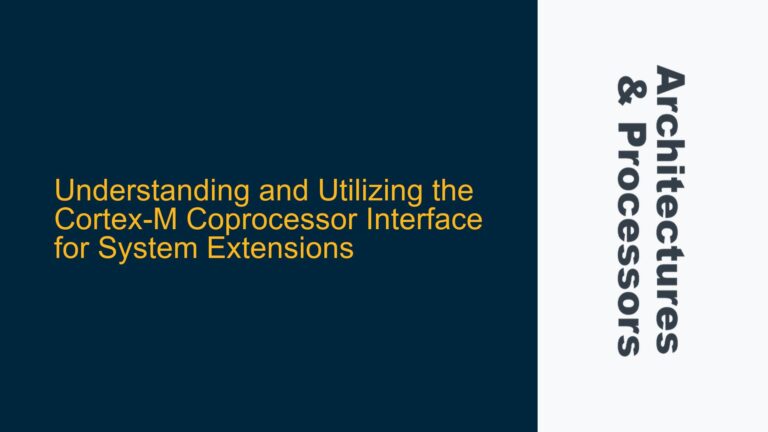ARM Cortex-M4 Functional Unit Power Consumption Analysis
The ARM Cortex-M4 processor, like many modern microcontrollers, is designed with power efficiency in mind. However, understanding the power consumption characteristics of its functional units—such as the Arithmetic Logic Unit (ALU), memory access units, and register banks—is critical for optimizing energy usage in embedded applications. Functional units are activated or deactivated based on the instructions being executed, and this activation/deactivation can lead to variations in current consumption. For instance, an ADD instruction activates the ALU, while a NOP instruction may leave it idle. Measuring these current variations can provide insights into the power profile of the processor and help identify opportunities for optimization.
The challenge lies in isolating the power consumption of individual functional units from the overall system power consumption. The Cortex-M4, like other ARM processors, has a complex power profile influenced by factors such as clock gating, memory access, and peripheral activity. The power consumed by functional units is often overshadowed by the power consumed by other components, such as flash memory, oscillators, and clock buffers. Therefore, measuring the current variation due to functional unit activation requires a systematic approach, including careful control of the processor’s operating conditions and the use of precise measurement tools.
Impact of Instruction Sequences on Register Bank and ALU Power Consumption
The power consumption of the ARM Cortex-M4’s functional units is closely tied to the instructions being executed. For example, a sequence of NOP instructions minimizes activity in the register bank and ALU, as no data processing or register writes occur. In contrast, a sequence of ADD instructions activates the ALU and requires the register bank to store the results, leading to higher power consumption. This difference arises because the register bank must remain active to handle the writes, while the ALU performs the arithmetic operations.
The relationship between instruction sequences and power consumption can be further understood by examining the processor’s microarchitecture. The Cortex-M4 employs clock gating to reduce power consumption by disabling clocks to inactive functional units. When a NOP instruction is executed, the ALU and register bank may be clock-gated, reducing their power consumption. However, when an ADD instruction is executed, the ALU and register bank are activated, increasing power consumption. The extent of this increase depends on factors such as the number of consecutive ADD instructions, the operands involved, and the processor’s clock speed.
To measure the current variation due to functional unit activation, it is essential to design test sequences that isolate the activity of specific functional units. For example, a loop containing only NOP instructions can serve as a baseline for measuring the power consumption of the processor with minimal functional unit activity. By replacing some NOP instructions with ADD instructions, the additional power consumption due to ALU and register bank activity can be observed. However, the power consumption of other components, such as the instruction fetch unit and memory system, must also be considered, as they remain active regardless of the instructions being executed.
Techniques for Measuring Current Variation in ARM Cortex-M4
Measuring the current variation due to functional unit activation in the ARM Cortex-M4 requires a combination of software and hardware techniques. The following steps outline a systematic approach to achieving this:
-
Baseline Measurement with NOP Instructions: Begin by creating a loop containing only NOP instructions. This loop serves as a baseline for measuring the processor’s power consumption with minimal functional unit activity. Use a precision current measurement tool, such as a digital multimeter or an oscilloscope with current probes, to record the current consumption during the execution of this loop. The measured current represents the power consumption of the processor’s core components, excluding the ALU and register bank.
-
Introduce ADD Instructions: Replace some NOP instructions in the loop with ADD instructions. The number of ADD instructions should be chosen to ensure that the ALU and register bank remain active for a significant portion of the loop’s execution time. Measure the current consumption during the execution of this modified loop. The difference between this measurement and the baseline measurement provides an estimate of the additional power consumption due to ALU and register bank activity.
-
Analyze Power Patterns: Use an oscilloscope to capture the power consumption waveform during the execution of the test loops. Look for patterns or glitches that correspond to specific instructions or instruction sequences. For example, a spike in power consumption may occur when a branch instruction is executed, as the instruction fetch unit and memory system are heavily utilized. Comparing the power patterns of the NOP and ADD loops can reveal the impact of functional unit activation on current variation.
-
Control Clock Settings: Ensure that the processor’s clock settings are consistent across all measurements. Variations in clock speed can significantly affect power consumption, making it difficult to isolate the impact of functional unit activation. Use the processor’s clock control registers to set a fixed clock speed and disable any dynamic clock scaling features.
-
Minimize Peripheral Activity: Disable all unnecessary peripherals and interrupts to reduce their impact on power consumption. The goal is to isolate the power consumption of the processor’s core components, including the functional units, from the power consumption of other system components.
-
Repeat Measurements: Repeat the measurements multiple times to ensure consistency and accuracy. Power consumption can vary due to factors such as temperature and supply voltage, so averaging multiple measurements can help reduce measurement noise.
By following these steps, it is possible to measure the current variation due to functional unit activation in the ARM Cortex-M4. However, it is important to note that the power consumption of individual functional units is often small compared to the overall system power consumption. Therefore, the observed current variation may be subtle and require precise measurement tools and techniques to detect.
Practical Considerations and Limitations
While the techniques described above provide a framework for measuring current variation in the ARM Cortex-M4, several practical considerations and limitations must be taken into account:
-
Measurement Precision: The power consumption of individual functional units is often in the microampere range, making it challenging to measure accurately. High-precision current measurement tools, such as low-noise amplifiers and high-resolution oscilloscopes, are essential for detecting small changes in current consumption.
-
Instruction Fetch Overhead: The power consumption of the instruction fetch unit and memory system can overshadow the power consumption of functional units. Even in a loop of NOP instructions, the instruction fetch unit remains active, fetching and decoding instructions. This overhead must be accounted for when interpreting measurement results.
-
Clock Gating Effects: The Cortex-M4 employs clock gating to reduce power consumption, but the extent of clock gating can vary depending on the specific implementation and configuration. For example, some implementations may aggressively gate clocks to inactive functional units, while others may leave them partially active. Understanding the clock gating behavior of the specific processor being used is critical for interpreting measurement results.
-
Temperature and Voltage Variations: Power consumption can vary with temperature and supply voltage. Ensure that the processor operates at a stable temperature and voltage during measurements to minimize these variations. If necessary, use a temperature-controlled environment and a regulated power supply.
-
Software Overhead: The test loops used for measurement introduce some software overhead, such as loop control instructions and branch instructions. This overhead can affect power consumption and must be considered when designing test sequences. Minimize the overhead by using simple loops and avoiding complex control structures.
-
Hardware-Specific Factors: The power consumption of the Cortex-M4 can vary depending on the specific hardware implementation, such as the manufacturing process, package type, and board design. These factors can affect the absolute power consumption values and the observed current variation. When comparing results across different hardware platforms, consider these factors and adjust the measurement setup accordingly.
Advanced Techniques for Power Analysis
For more advanced power analysis, consider using specialized tools and techniques, such as:
-
Power Profiling Tools: Some development tools and IDEs, such as NXP’s LPCXpresso IDE, include power profiling features that can measure and analyze the power consumption of the processor during code execution. These tools can provide detailed insights into the power consumption of individual functional units and help identify power-hungry code segments.
-
Simulation and Modeling: Use simulation tools to model the power consumption of the Cortex-M4 and its functional units. These tools can provide a theoretical understanding of the power consumption characteristics and help predict the impact of different instruction sequences and configurations.
-
Hardware Modifications: In some cases, hardware modifications may be necessary to isolate the power consumption of specific functional units. For example, adding current sense resistors to the power supply lines of individual functional units can provide more precise measurements. However, this approach requires careful design and may not be feasible for all applications.
-
Statistical Analysis: Use statistical techniques to analyze the power consumption data and identify trends and patterns. For example, calculate the mean, standard deviation, and confidence intervals of the measured current values to assess the reliability of the results.
Conclusion
Measuring the current variation due to functional unit activation in the ARM Cortex-M4 is a challenging but valuable task for optimizing power consumption in embedded systems. By understanding the power consumption characteristics of the processor’s functional units, developers can design more energy-efficient applications and extend battery life in portable devices. The techniques described in this guide provide a systematic approach to measuring current variation, but they require careful attention to detail and precise measurement tools. With the right setup and methodology, it is possible to gain valuable insights into the power profile of the Cortex-M4 and make informed decisions about power optimization.






